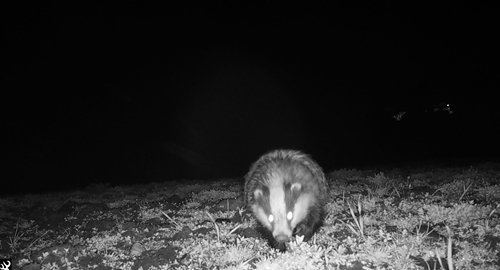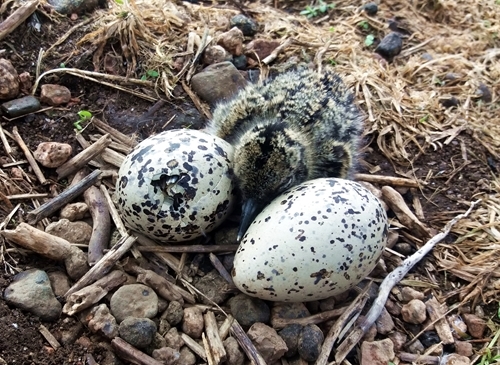Written by Dave Parish, Head of Scottish Lowland Research
5 Minute Read

This year we have published two blogs (here and here) reporting unusually high levels of badger predation on early lapwing clutches at our demonstration farm, Auchnerran. Predation is always the principal cause of wader egg loss at Auchnerran, as at many sites, but this year it is higher. The blogs generated a lot of interest, and we’d like to thank all those who took the time to comment. Some of the comments suggested a misunderstanding of what we are trying to achieve with the blogs and at Auchnerran (there is lots of background information about the farm in our annual reports).
Auchnerran is not a nature reserve but we take great pride in being working conservationists. Auchnerran is first and foremost a sheep farm, operating just as many other similar farms, with a typical small sustainable shoot. We use an ‘adaptive management’ approach, monitoring our biodiversity and ecosystem services to see how they respond to our activities (e.g., farming, habitat management, predator control). We then adapt to minimise negative impacts and maximise the positives, whilst maintaining the farm’s productivity. Our aim is to produce a net biodiversity gain.
What does this mean in practice? We lime and fertilise some of our grass so it is the best it can be whilst operating diligently at all times, minimising our impacts via sensitive vehicle use and late rolling and cutting of silage fields, for example, which allows time for our hare and nationally important wader populations to breed. We also embrace those areas of the farm that cannot be agriculturally improved and maximise their natural capital value. The incentive of a small, sustainable shoot of wild game motivates us to plant pollen and nectar rich cover crops, ensure farmland birds are fed from winter into spring and carry out the legal control of crows, rats, foxes and stoats, especially during the spring and summer, ensuring the ground breeding animals do so really well.
An alternative, wilder, approach to conservation often advocated today is not to intervene at all. Some species at Auchnerran may benefit in the short term, but equally certain would be the demise of others – including our waders. In our view, the adaptive management approach is the best way to tackle conservation challenges at Auchnerran. Studying what is or isn’t effective allows us to have a balance between species, something especially important for those which are nationally vulnerable and those which are highly successful.

Our attention to ‘best practice and proof’ means Auchnerran is ideal for research and demonstration. We explore new approaches to conservation, and share those findings whatever they may be, so that all land managers might implement effective conservation practices, producing landscape-scale benefits. The recent results regarding badger predation on lapwing eggs is a case in point. For Auchnerran, the level of badger predation recorded earlier this year was unprecedented and so warrants further investigation. It is true that assigning predator identity to predation events is hard, but even if we have overestimated by a factor of two, the level of badger predation would still be unprecedented. Our findings are of real conservation importance to the farm, the region and possibly nationally. The total level of clutch predation (somewhere around 50% at present) is unsustainable and if it became the norm in future years would probably lead to Auchnerran becoming a population sink for lapwing rather than a source as it is at present.
Clearly we aren’t saying that all the sad declines in Britain and Scotland’s wading birds are due to badgers. Intensifying agricultural practices were at the heart of the historical population declines of waders and so far, the badgers’ contribution, if any, has hardly been studied in many settings. But it is incorrect to suggest that this means the predation rate we have found is of no consequence. Research by many conservation bodies shows that predation of eggs and young, by a suite of predators, is increasing and is now the main factor causing wader population declines or preventing recovery over most of their range.
This brings us back to what we are doing at Auchnerran and why. Our recent findings raise two interesting and important questions: 1) why has predation changed this year and, 2) how can we reduce it in future to sustainable levels?
Badger predation on eggs may have risen this year because the prolonged cold and dry spring weather may have made the badgers’ staple prey of earthworms, or other food such as rabbits, less available. We will explore this by comparing data on badger predation rates this year with colleagues elsewhere and looking back through our historical records. Or there may simply be more badgers this year than previously – our data from annual monitoring will clarify this. We also plan to improve our monitoring of badger movements across the farm to understand how and when they use different areas, including – subject to funding – genetic analyses to determine accurately how many individuals are present and, if possible, how many individuals might be responsible for the clutch predation we’ve found.
This knowledge will help us reduce badger predation in future, something we must consider if the farm’s net conservation value is to be protected. We are exploring the practicalities of deterring badgers from key areas, whilst maintaining access to the rest of the farm. Our data suggest that the wire-netting protecting forage and game crops from our burdensome rabbit population does deter badgers. This requires more study to confirm and is not a perfect solution as the badgers periodically break through. It may also be possible to use temporary electric fencing in some areas when waders are breeding, if there are no sheep in the area, or perhaps olfactory deterrents (i.e., nasty smells). Perhaps emerging technology will provide a solution - preliminary data from other researchers suggest that badgers avoid some colours of laser light projected on the ground near them. Or we may be able to make less sensitive areas of the farm more attractive to badgers by providing diversionary feeding.
As always, we will share our findings in full. Indeed, we would welcome the opportunity to show anyone interested what we’re doing, so if you would like to visit Auchnerran, please get in touch.